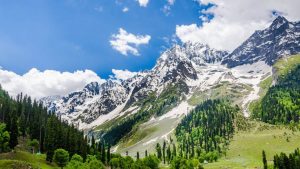Last Updated: June 27, 2019 Durga Prasad Dash
For the Christmas vacation of 2015, the initial plan was to go somewhere far away, outside Karnataka. But plan A did not work out somehow. So here was the plan B – why not visit some nearby tourist places of Karnataka that we have been postponing visiting for years. A day before the visit, we decided, our 2/3 days journey would start with Shravanabelegola, then on to Shringeri through Belur and Halebeedu.
Sharavanbelagola
So, early one morning towards the close of 2015 we hit the road, me – the driver, Subha – my wife as the mentor and Dipayan – our 13 year old son as the official navigator.
Our first destination was Shravanabelagola which is about 160 kms from Bangalore.
As I learn that some years back the statue of Gommatesvara at Shravanabelagola was voted overwhelmingly in a Times of India poll as the first of the seven wonders of India, I wonder, “how come I have missed such a wonderful site even though I have stayed in Karnataka off and on for over 10 years.”
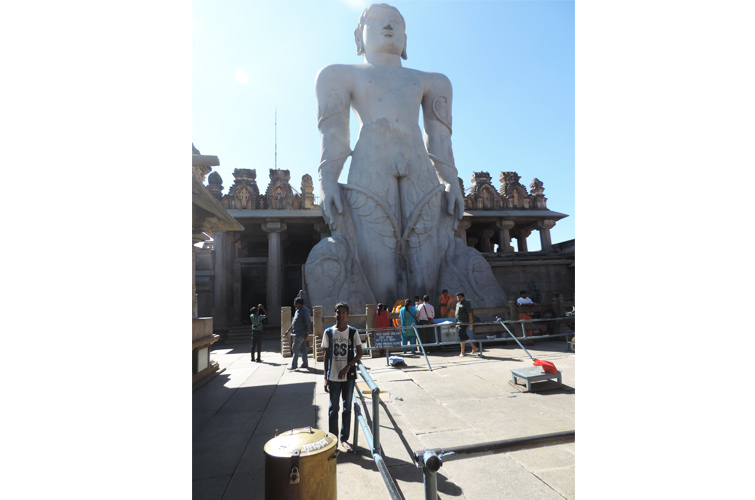
Belagola means white pond and shravakas are Jain seekers. As the place is famous for both, it is named as Shravanabelagola. There is a beautiful pond- even though no more white – in the middle of the town which is flanked by two hills Vindhyagiri and Chandragiri.
On Vindhyagiri stands the majestic monolithic 57 feet high statue of Gommatesvara. There is no alternate to climbing barefoot or with socks the 650 odd steps to reach the sacred footstep of Lord Gommatesvara. Of course there are palanquin bearers for those who cannot climb. To reach the top, it takes a leisurely half an hour. There is no need to hurry. It would be better to take frequent breaks not only to stabilize breath, but also to appreciate the surrounding views as you climb.
And of course to click those selfies to share on the social media.
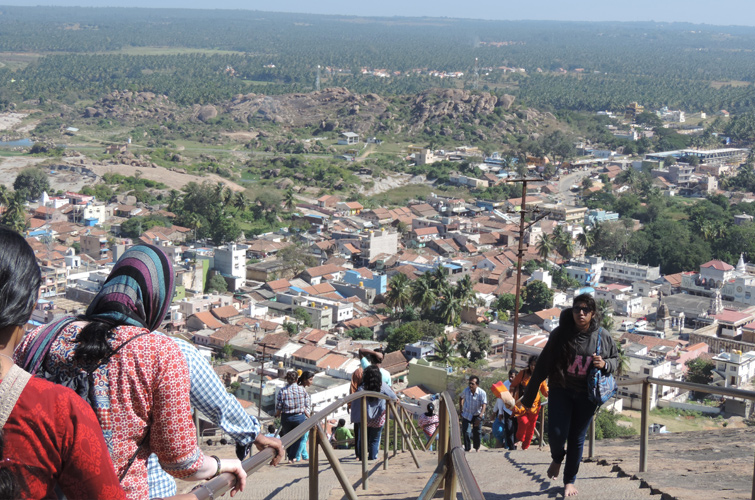
View from Vindhyagiri
As you climb up the Vindhyagiri Hill you can have a bird’s eye view of the Shravanabelagola town and the Chandragiri Hill across the town. It is here at Shravanabelegola that the Mauryan Emperor Chandragupta Maurya lived the last years of his life after converting to Jainism. On Chandragiri hills are a number of memorials to various Jain monks and a temple.
While climbing up the hill, you have the feeling that you are rising above the mundane affairs of the world and the majestic statue standing high on the mountain radiating bliss is inviting you to rise above the worldly worries and obtain the peak of bliss and innocence.
As one reaches the top of the hill through the winding steps one cannot but stand in awe of the magnificent statue of Gommatesvara Bahubali. Let it not be identified with the fictionalized character Bahubali of the eponymous multilingual movie.
When the movie Bahubali was released it drew protests from the Jain Community. May be, I think rightly so, they feared that the movie will evoke wrong associations and ideas concerning Jain History which is already misrepresented on many accounts by the scholars of Indian History.
On the rocks on both the hills are a large number of Kannada inscriptions that have survived the ravages of time for a thousand years. These have provided valuable information to the historians and archaeologists. However to me what was of special interest was the story of Bahubali written on a large board.
The story of Bahubali
Bahubali is the son of the first Jain Tirthankar – Rishavdeb who was the king of Ayodhya before entering into ascetic life. Rishavdeb had one hundred sons and two daughters through his two wives. Prominent among the sons were Bharat and Bahubali. Before renouncing worldly life, Rishavdeb crowned Bharat as the king of Ayodhya and Bahubali as the king of Taxshila. Other 98 sons were also made kings of various remaining provinces.
Bharat was highly ambitious. After subjugating 98 brothers he wanted Bahubali to surrender his kingdom. But Bahubali, which literally means the strong armed, would not consent. So war became inevitable. Fearing large scale devastation, the learned from both the sides, suggested a novel method – instead of the armies of both the sides engaging in battle, let there be a duel between the two brothers. Perhaps, it was keeping in line with the Jain principle of Ahimsa or where total Ahimsa was not possible to go for minimum collateral damage. Bharat was defeated in all the three rounds of the duel. But instead of being humbled, the defeat only infuriated him more and he sent his special weapon, known as Chakraratan – a wheel bestowed with magical powers, to kill Bahubali. To everyone’s surprise the weapon could not even touch Bahubali.
At first Bahubali was enraged. However, a sudden realization dawned on him and made him wonder about the futility of war and the craving for worldly gains. Thus, humbled in victory, Bahubali gave away his kingdom to Bharat and set on the journey of self-discovery. He engaged in deep meditation in the standing posture for such a long time that creepers grew over his legs. With a little help from Rishavdeb, Bahubali finally became enlightened.
Climbing down, awestruck
Awestruck, as I climb down the Vindhyagiri, I cannot but agree with what the famous journalist Vir Sanghvi had written in an article after visiting Shravanabelagola – “It is a sobering thought that around 500 years before Michelangelo created his David, Indian craftsmen had created a statue that is much more beautiful and far more impressive. ….. Long before the European Renaissance and long before the great structures of the medieval era – such as the Taj Mahal – were created, India had a cultural heritage that was the envy of the world”.
The head anointing ceremony
Every 12 years, the head anointing ceremony known as Mahamasthakabhisheka is performed in an elaborate ritual where in the idol is bathed in sacred liquids like sandal paste, milk, ghee, turmeric paste etc. The grand ceremony, that draws millions of people, culminates with the showering of flowers from a helicopter. The next one is scheduled to be held in February 2018.
The message of Gommatesvara Bahubali
Bahubali, the strong armed one, stands alone, naked, innocent and majestic radiating bliss and peace atop mount Vindhyagiri to announce to the world that to patronize non-violence requires unsurpassed strength. It is not a sign of meekness and weakness. Defeat need not always humble someone. Real victory is victory over one’s own negative tendencies and ignorance.
Belur and Halebidu:

Panaromic View Belur Temple
Our next destination on the heritage tour was Halebidu which is at a distance of about 80 Kms from Shravanabelagola. We reached there by lunch time, hungry enough to devour whatever was on offer. So we did not mind the shanty hotel near the Hoysaleswara temple offering typical south Indian Thali.
Belur and Halebidu bear the testimony to not only the grand and distinct architectural style as the Hoysala style of architecture, but also the ravages done to a culturally advanced society by the barbaric Muslim invaders from time to time. A UNESCO study says that out of the 1500 temples built by the Hoysala rulers, only 100 survive today. Many temples were destroyed by the army of All-ud-din Khilji led by his general – Malik Kafur.
Belur was the first capital of the Hoysala Rulers whose empire spread all over Karnataka and some of the neighboring states. During their reign from the 10th to 14th century AD, art, architecture literature and spiritual practices thrived due to generous patronage of not only the rulers but also the influential citizens. In addition to the places of religious rituals, the temples served as centers of art and culture and sometimes even as courts. The Hoysala style attempted to achieve grandeur in ornate design with profusion of intricately carved stone sculptures, in contrast to the temples of other styles built to grand size , both vertical and horizontal.
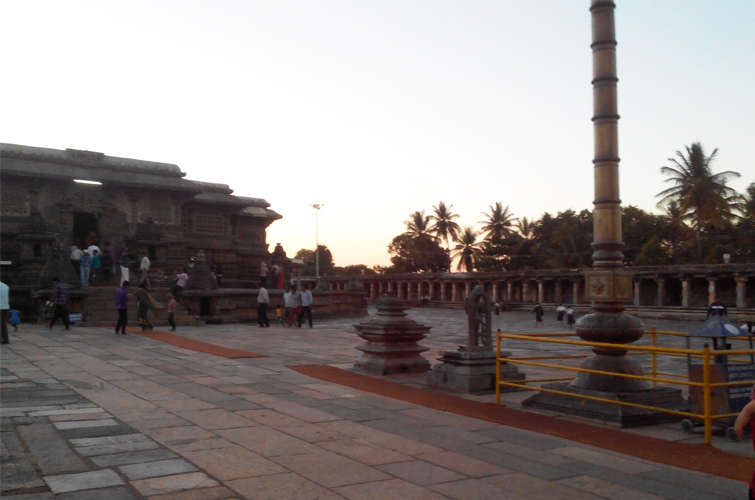
Chennakesava Temple, Belur
The Chennakesava temple at Belur was commissioned in the early part of the 12th century by King Vishnuvardhana. The Vaishnavite Temple was earlier known as Vijayanarayana Temple to commemorate the victory of King Vishnuvardhana over the Chalukyas, as one legend goes. It is said that the Saivite Hoysaleswara temple at Halebidu was built by prominent merchants to rival the Chennakesava Temple in grandeur and glory. However after the completion of the temple it was dedicated to King Vishnuvardhana, who shifted his capital to Dwarasamudra which was later on called as Halebidu meaning the Old City. Some say King Vishnuvardhan was converted to Vaishnavism from Jainsim and his wife Shantala was also a Jain. Nevertheless, she patronized many Hindu temples. Overall, it is seen that during the Hoyasala period, a highly culturally and intellectually developed plural society developed making immense contribution to Indian and Kannada art, culture and literature.
The main attraction of Halebidu are the two conjoined temples of Hoysaleswara and Shantaleswar. There is an archaeological museum inside the compound of the temple. Other places of interest are the Kedareswara temple (also built in Hoysala style) and the Jain Basadi which are at short distance.
I was intrigued by the story behind the Garuda Pillar to the south side of the Hoysaleswara Temple. Usually Vishnu’s vahana Garuda sits on the Garuda pillar in front of many Vaishnavite temples. However, this Garuda Pillar here is erected in honor of the body guard of King Ballala II. I learn that Garudas were highly skilled and loyal body guards of the kings. With the death of the king they served, they also ended their lives. In this particular case, the body guard Kuruva Lakshma was so loyal that he took the life of his whole family along with his own.
Inside the the Chennakesava Temple at Belur are a number of other temples, some added later on after the consecration of the main Vishnu Temple. As I enter the large temple compound in the afternoon, roam around and sit down for a while to meditate, it gives one a feeling of timelessness. Nothing much has changed inside the temple during the last 800 years, including the form of temple ritual that has been carried on without even a day’s break .Of course men have come and men have gone. The carvings on the outer walls and the inscriptions provide valuable information and hints about the life in those days.
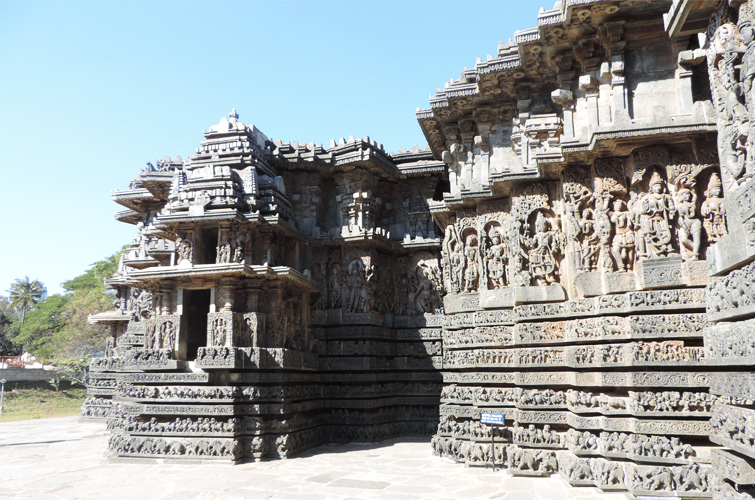
Halebid intricate carvings
Each image, each carving has a story to tell and they are in thousands. The history and archeology enthusiast may need months to explore and fathom them. Even for a casual visitor, one day is definitely not enough to appreciate various historical land marks (that includes Hoysala-style step wells) spread in and around Belur and Halebidu.
At the end of a tiring day, falling asleep was not much of a problem. However certain vague and dreamlike feelings lingered on as I felt being transported back in time to those golden days of history. I hear the sounds of sculptors chiseling and bringing into life, lifeless objects, with the hope that the creations outlived the creators. I see them signing off their work with a feeling of pride and accomplishment (literally, because many of the carvings bear the name of the sculptor in local language). On various pandals inside the temple, discourses and discussions are going on as to the origin of the universe, the nature of reality and the ultimate aim of life. In another corner, the compositions of poets find expressions through accomplished dancers and singers. In the streets outside, the common citizens carry on with their lives as usual while the threat of battle and devastation looms large. Soldiers return from battle, wounded and tired, yet surviving to tell the tales of camaraderie, courage and victory.
Sringeri:
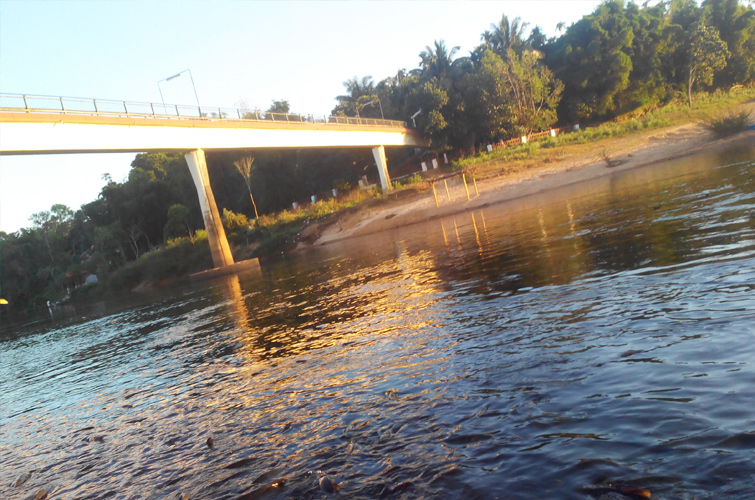
Sringeri
Shravanabelagola, Halebid and Belur have been proposed to be included in the list of UNESCO heritage sites. There has been no such recommendation for Sringeri. May be because, Sringeri does not boast of any monument of architectural grandeur. Nevertheless it is an important landmark contributing to the notion called India and towards the preservation of ancient Indian spiritual and intellectual heritage. Thus seen, it is no less a heritage site than Shravanabelagola.
The 100kms odd journey from Belur to Sringeri was mesmerizing. The winding road through the ghat sections of Chikmagalur district is flanked by coffee estates. In between there are stretches of roads that are in need of repair and it slows down our journey. Otherwise also, we stop frequently to have a panoramic view of the surroundings and examine the plantations of the estates. My wife gets fascinated with the creepers that grow on the tall trees which provide a canopy to the coffee plants. We learn that these are the creepers that produce black pepper. We reached Sringeri long before lunch time to take a little rest and visit the temples of Sringeri Sarada Peetham. The guest houses constructed and maintained by Sharada Peeham are well maintained and the charges are very nominal. Of course one can opt for one of the more expensive private lodges or home stays located throughout the town and the outskirts.
Sringeri is a small town with a population of about 5000 and is situated on the southern side of the river Tunga. There is ample parking place in between the town and the river and adjacent to the Sarada Peetham.
The majority of tourists were school children who came as a part of their annual excursion during the Christmas vacation. It was a bit crowded. At other times we may not see so many footfalls. As the place was meant to be a citadel of learning and contemplation for those who took to the monastic order, it would be fitting if the place is not filled with bustling crowds all the year round.
However, there is a story behind the place being chosen to be the first of the four original ‘Maths’ established by Adi Shankara. While passing through Sringeri, Adi Shankara saw a unique site near River Tunga. It was a very hot day and a snake had spread its hood over a frog to shelter it from hot sun. Adi Shankar could discern the special vibes permeating the place. The story has a modern parlance. Huge number of fish gather at the river bend near the temple to be fed with puffed rice by the human beings. They have so much faith of not being caught and fried that they come near you without any iota of fear or hesitation. Truly, it is a place with special vibes. The presence of ancient temples, the river flowing by leisurely and the green mountains standing still create a serene and peaceful atmosphere.
Here it may be remembered that today there are hundreds of swamis and saints who claim to be the torch bearers of the traditions started by Adi Shankaracharya. However, Adi Shankar established only four ‘Maths’ – one each in the southern, western, northern and eastern part of India, entrusting each Math to be administered by one of his four prominent disciples- Sureshwara, Hastamalaka, Totakacharya and Padmapada. Thus, in the south we have the Sharada Peetham at Sringeri, in the west at Dwaraka we have the Dwarakapeetha, Jyotirmath is located at Badrinath in the north and at Puri in the east we have Govardhan Peetha. Presently the Sharada Peetham is headed by Sri Sri Bharati Tirtha Mahaswamiji who is the 36th in the lineage of head pontiffs of the Peetham.
The temples of Sri Saradamba, Sri Toranaganapati, Sri Vidyashankar, Sri Adishankara and another dozen odd temples are located inside the temple complex on the southern bank of the River Tunga. Sri Vidyashankar Temple was constructed in 14th century combining Hoysala and Dravidian style of architecture. Different temples inside the complex have been constructed at different times. Our visit and prayers at the temples on the southern side culminated with the partaking of the free lunch (annaprasada) inside the temple complex. The lunch consisting of kheer, rice, sambhar and butter milk was simple yet sumptuous. Temple authorities claim that every day on an average of 8-10 thousand people are provided free lunch and dinner.
In the evening we went to the northern side of the peetham across the river. A narrow high bridge over river Tunga connects both sides of the premises of the peetham. Of course, nearby there is another hanging foot bridge for the use of the villagers on the other side of the river. The northern side across the river houses the living quarters of the pontiffs, other swamis and disciples. It has the ambience of an Ashram. One can have an audience with the head pontiff Sri Sri Bharati Tirtha Mahaswamiji and his successor designate Sri Vidhusekhar Bharati at prescribed timings in the morning and evening subject to their availability at Sringeri. Luckily for us on that day both of them were available for darshan.
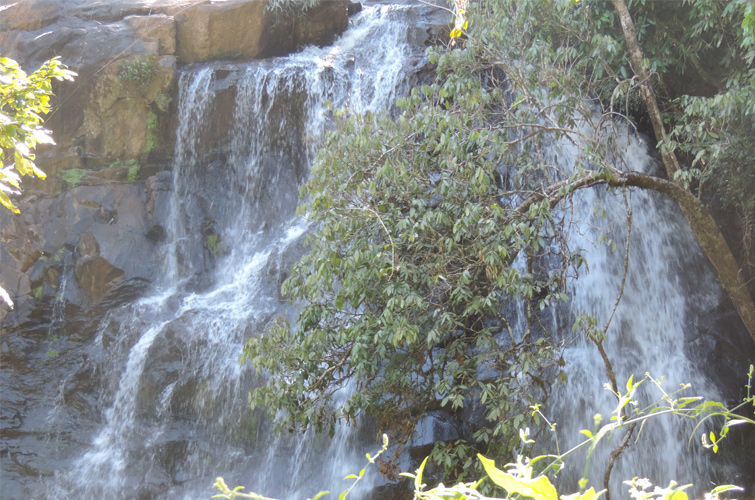
Sirimane falls
There are a number of other temples in and around Sringeri. Another interesting place that we visited in the afternoon was the Sirimane Falls located at a distance of about 20 kms from Sringeri. Even though the road was so bad that it created doubts as to whether it would survive the next few days to be regarded as any kind of motorable road, the waterfall was worth a visit. Here again the crowd consisted primarily of sportive school students running to enjoy a bath while their shouting, reprimanding, threatening guardians and teachers played the spoilsport.
Published: 06 May, 2016
From the culturally rich and diverse land of Orissa, Durga Prasad Dash is a travel enthusiast, a passionate writer, and a yogi. All thanks to his previous job in Indian Air Force, he been to almost every part of India, but his lust to explore new places and adventurous spirits are never ending. He loved to learn about different cultures and lifestyles and inspires other for the same through his writing. To know more about his travel stories, check out his blog


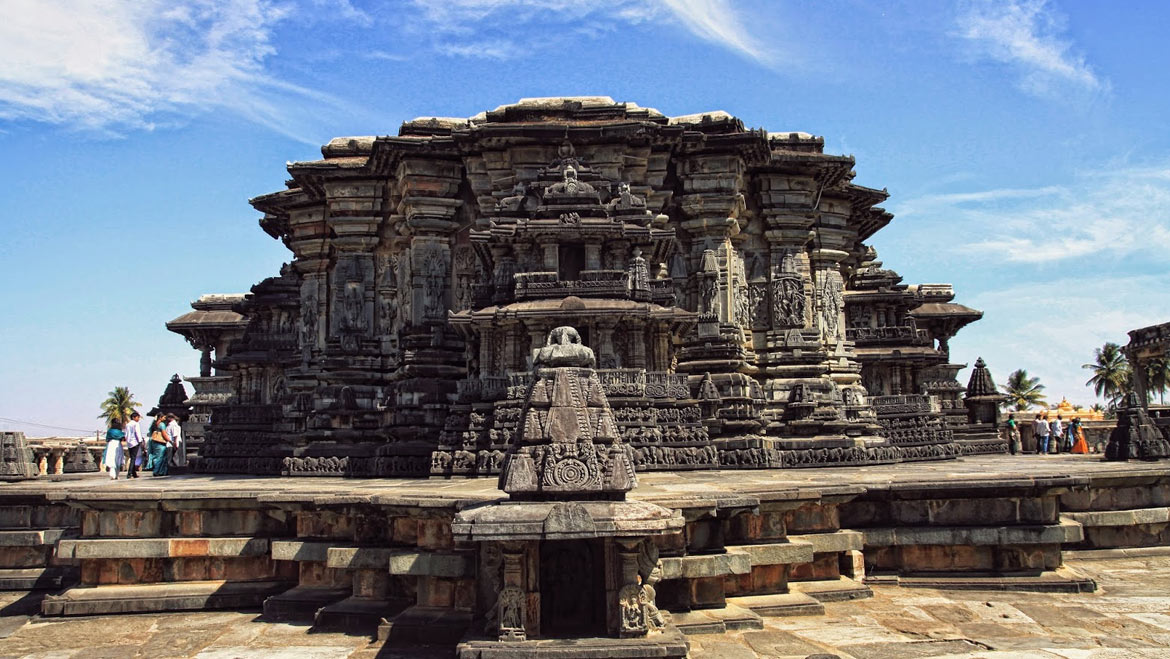
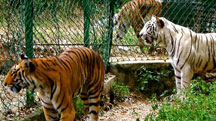 5 Nights / 6 Days
5 Nights / 6 Days 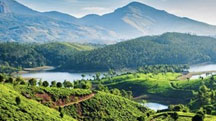 7 Nights / 8 Days
7 Nights / 8 Days 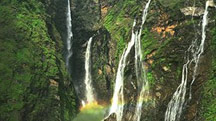 3 Nights / 4 Days
3 Nights / 4 Days 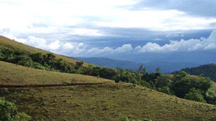 2 Nights / 3 Days
2 Nights / 3 Days 








